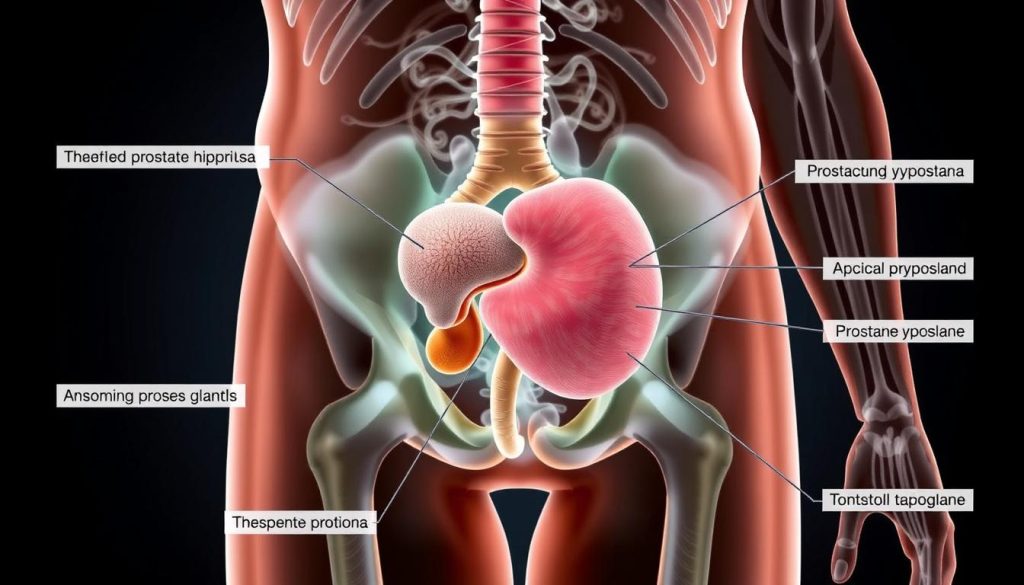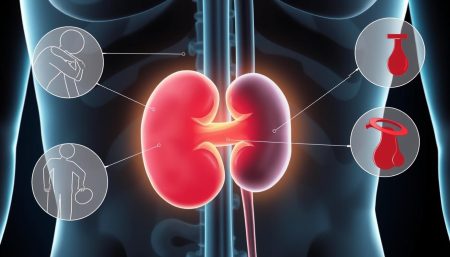An enlarged prostate can worry many men. They often wonder if it means cancer. This guide will look into the connection between prostate growth and cancer, easing common fears.
We’ll explain why prostates get bigger and how to spot cancer. You’ll learn about symptoms, tests, and treatment options. Our aim is to provide clear, reliable info on prostate health.
Knowing about prostate changes is crucial for early detection and care. Let’s explore what an enlarged prostate means for your health and when to get help.
Does An Enlarged Prostate Mean Cancer: Understanding the Difference
Many men worry about cancer when they hear about prostate health issues. This part explains the difference between benign prostatic hyperplasia (BPH) and prostate cancer. Both are common in men but have different effects on health.
Understanding Benign Prostatic Hyperplasia (BPH)
BPH is when the prostate gland gets bigger but it’s not cancer. It happens more often as men get older. It can make it hard to pee but doesn’t raise cancer risk.

Defining Prostate Cancer and Its Characteristics
Prostate cancer is when the prostate gland grows cells that shouldn’t. It’s different from BPH because it can spread. Finding it early is key to treating it well.
Key Differences Between BPH and Prostate Cancer
| Aspect | BPH | Prostate Cancer |
|---|---|---|
| Nature | Non-cancerous growth | Cancerous cell multiplication |
| Spread | Confined to prostate | Can metastasize |
| Symptoms | Primarily urinary | May be asymptomatic initially |
| Treatment | Focused on symptom relief | Aims to eliminate cancer cells |
Knowing the difference between BPH and prostate cancer is important. Even if your prostate gets bigger, it doesn’t always mean you have cancer. Still, it’s vital to get regular check-ups for early detection and the right treatment.
Common Symptoms and Warning Signs of Prostate Problems
Spotting prostate symptoms early is key to keeping your prostate healthy. Men often notice signs that might mean there’s a problem with their prostate gland. It’s important to know these signs to get help quickly.
Urinary Symptoms and Their Significance
Urinary issues are common signs of prostate problems. Many men see changes in how they pee, which can be a worry. These changes might include:
- Frequent urination, especially at night
- Weak urine stream or trouble starting to pee
- Urgent need to pee
- Not feeling like you’ve emptied your bladder fully
These symptoms can really affect your life and might mean you need to see a doctor. Prostate cancer can also cause similar urinary problems, so getting checked is very important.
Physical Changes and Discomfort
Men might also feel physical changes or discomfort due to prostate issues. These can include:
- Pain or burning when you pee
- Discomfort in your lower back, hips, or pelvic area
- Trouble getting an erection or changes in sex life
- Blood in your pee or semen

When to Seek Medical Attention
Some prostate symptoms might seem minor, but others need quick medical help. If you have:
| Symptom | Action Required |
|---|---|
| Persistent urinary problems | Schedule an appointment |
| Blood in urine or semen | Seek immediate care |
| Sudden severe symptoms | Emergency evaluation |
| Unexplained weight loss or tiredness | Prompt medical assessment |
Getting problems with your prostate treated early can make a big difference. Regular check-ups and talking openly with your doctor are important for keeping your prostate healthy.
Diagnostic Methods for Prostate Conditions
Finding prostate problems early is key to treating them well. Doctors use many ways to spot prostate issues, like cancer. These tests help check the prostate’s health and decide on treatment.
The digital rectal exam (DRE) is often the first step. A doctor feels the prostate gland through the rectum. They look for any odd sizes, shapes, or textures. It’s not a sure sign, but it can show possible problems.
PSA levels are checked through a blood test. PSA screening is a major tool in finding prostate cancer. High levels might mean cancer, but can also show other issues.
If tests suggest a problem, a prostate biopsy might be suggested. This involves taking small tissue samples from the prostate. It’s the best way to confirm prostate cancer.
| Diagnostic Method | Purpose | Invasiveness |
|---|---|---|
| Digital Rectal Exam | Physical assessment of prostate | Minimally invasive |
| PSA Blood Test | Measure PSA levels | Minimally invasive |
| Prostate Biopsy | Definitive cancer diagnosis | Invasive |
Regular prostate cancer screening is crucial, especially for men over 50 or those with risk factors. Finding cancer early greatly improves treatment results and life quality.
Risk Factors and Prevention Strategies for Prostate Health
Knowing about prostate cancer risk factors is key to keeping your prostate healthy. Age, family history, and lifestyle choices all affect your risk. Let’s look at these factors and talk about how to prevent prostate cancer.
Age-Related Risk Factors
As men get older, their risk of prostate problems goes up. Most prostate cancer is found in men over 50, with an average age of 66 at diagnosis. It’s important to get regular screenings as you age to find problems early.
Lifestyle and Environmental Influences
Your daily habits can affect your prostate health. Eating a lot of red meat and saturated fats may raise your risk. But, eating more fruits, vegetables, and whole grains can help protect you. Smoking and drinking too much alcohol also increase your risk of prostate cancer.
Preventive Measures and Healthy Habits
Being proactive about prostate health can really help. Regular exercise, staying at a healthy weight, and drinking plenty of water are all good. Some studies show that catching health problems early through regular check-ups can lead to better outcomes, including for prostate health.
| Preventive Measure | Potential Benefit |
|---|---|
| Regular exercise | Improves overall health, may reduce cancer risk |
| Balanced diet | Provides essential nutrients, supports prostate function |
| Stress management | Reduces inflammation, supports immune system |
| Regular screenings | Enables early detection and treatment |
By knowing about prostate cancer risk factors and taking steps to prevent it, you can manage your prostate health. Early detection and making healthy lifestyle choices are crucial for a healthy prostate all your life.
Treatment Options and Management Approaches
Prostate health depends on the condition. For benign prostatic hyperplasia (BPH), doctors might start with watchful waiting or lifestyle changes. If symptoms get worse, they might prescribe medications like alpha-blockers or 5-alpha reductase inhibitors. In severe cases, they might suggest minimally invasive procedures or surgery.
Prostate cancer treatment varies based on the cancer’s stage and how aggressive it is. For low-risk cases, active surveillance might be recommended. But for more aggressive cancers, surgery, radiation therapy, or hormone therapy might be needed. Advanced prostate cancer could require chemotherapy or immunotherapy. The aim is to tailor the treatment to each patient’s needs.
Monitoring is key, whether it’s for BPH or prostate cancer. Regular check-ups and PSA tests help track progress and adjust treatment plans. It’s vital to talk to your healthcare provider about all treatment options. Early detection and personalized care are crucial for prostate health and overall well-being.
FAQ
Q: Does an enlarged prostate always mean cancer?
A: No, an enlarged prostate doesn’t always mean cancer. Most often, it’s benign prostatic hyperplasia (BPH), a non-cancerous condition. It’s important to see a doctor to get a proper diagnosis and rule out serious conditions.
Q: What are the main differences between BPH and prostate cancer?
A: BPH is a non-cancerous growth that mainly affects urination. Prostate cancer is a malignant condition that can spread. BPH doesn’t increase your risk of prostate cancer. They need different treatments.
Q: What are the common symptoms of prostate problems?
A: Symptoms include frequent urination, especially at night, and difficulty starting or stopping urination. You might also have a weak urine stream or feel like your bladder isn’t empty. Pain or discomfort in the lower back, hips, or pelvic area can also occur. These symptoms can be from benign conditions or cancer.
Q: How is prostate cancer diagnosed?
A: Doctors use a digital rectal exam (DRE), prostate-specific antigen (PSA) blood test, and prostate biopsy to diagnose prostate cancer. Imaging tests like MRI might also be used. Your doctor will look at your symptoms, risk factors, and test results to make a diagnosis.
Q: What are the risk factors for prostate cancer?
A: Risk factors include age (over 50), family history, African American ethnicity, and certain genetic mutations. Diet, obesity, and lack of exercise may also play a role. But having risk factors doesn’t mean you’ll get prostate cancer.
Q: Can prostate cancer be prevented?
A: There’s no sure way to prevent prostate cancer, but you can lower your risk. Eat a balanced diet, exercise, maintain a healthy weight, and avoid smoking. Regular check-ups and screenings help catch it early.
Q: What treatment options are available for prostate conditions?
A: Treatment depends on the condition and its severity. For BPH, treatments include lifestyle changes, medications, or minimally invasive procedures. Prostate cancer treatments range from active surveillance to surgery, radiation, hormone therapy, or chemotherapy. Your doctor will choose the best treatment for you.
Q: How often should I get my prostate checked?
A: How often depends on your age and risk factors. Men should talk to their doctor about screening at 50, or earlier if they have risk factors. Your doctor will decide the best screening schedule for you.
Q: Can elevated PSA levels always indicate prostate cancer?
A: No, elevated PSA levels don’t always mean cancer. PSA levels can be affected by BPH, prostatitis, recent ejaculation, or medications. A high PSA level may need further investigation, but it’s not a definitive cancer diagnosis.
Q: Is a prostate biopsy always necessary if PSA levels are elevated?
A: Not always. Your doctor will look at your PSA level, how fast it’s rising, and your overall health. In some cases, they might recommend monitoring PSA levels or using other tests before a biopsy.


















